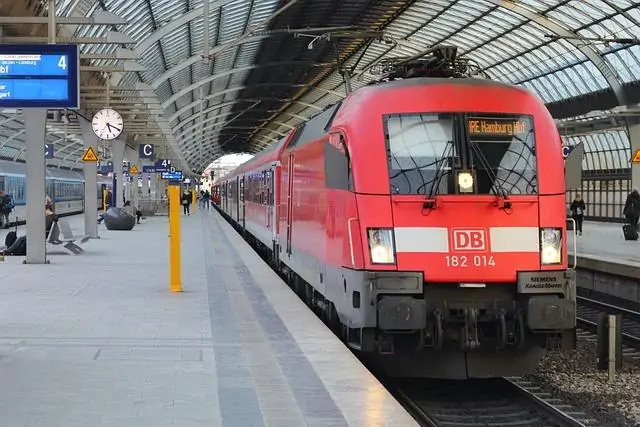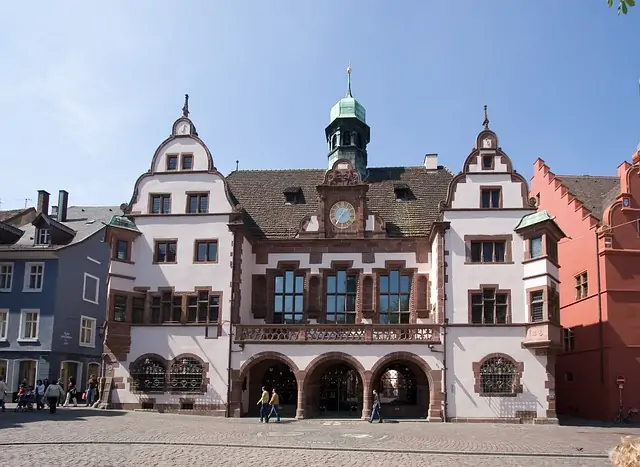This post contains affiliate links. It means that if you click on the links and make a purchase, we will receive a small commission at no additional cost to you. This allows our blog to continue providing you with free information. We only include links and products that we truly believe in. You can read the full disclosure here.
Moving to Germany or new in Germany? Check out our Resources Page for all the help you need!
When it comes to exploring the heart of Europe, there’s no better way than hopping on a train in Germany. In this guide, we’ll break down everything you need to know about train travel in Germany. From booking your ticket to understanding the train types and other insider tips, we’ve got your back. So, grab your ticket, and let’s embark on a train adventure in Germany!
Table of Contents
ToggleTrain companies in Germany
Germany has a diverse railway industry with several train companies operating both domestically and internationally.
Deutsche Bahn is the national railway company of Germany and one of the largest train operators in Europe. It covers a wide range of train types and routes, from high-speed journeys between major cities to regional travel within different states.
Besides Deutsche Bahn, you can also find private train operators in Germany such as FlixTrain, NordWestBahn, HKX (Hamburg-Köln Express), LEO Express, and others. They offer alternative options for rail travel, fostering competition.
Read also: Free Credit Card in Germany – Top 5 For Travel and Cashback
Different types of trains in Germany
Regional trains in Germany
Germany has a super well-connected web of regional trains that pretty much covers the entire country. Locals use them for daily commutes, and tourists use them to explore different places. Regional trains are not the flashy high-speed ones but do a fantastic job connecting smaller places.
Depending on where and when you’re traveling, regional trains can run every half-hour or hour. But in quieter areas, they might not show up as often.
These trains can look different – some are single-deck, while others have two decks. They’re either run by Deutsche Bahn (DB) or sometimes by other companies. But you can usually buy tickets for all of them on the DB website.
Many regional train stations have ramps and elevators to make it easy for passengers with disabilities. These trains also like to partner with other forms of public transport, like trams, buses, and subways. It’s like a one-ticket-fits-all deal, making it convenient to move around cities and regions.
There are different types of regional trains in Germany:
S-Bahn:
The S-Bahn is the most frequent type of regional train, and it can show up as often as every few minutes.
Think of S-Bahn trains as the city’s commuter buddies. They can cover quite a distance, but they’re mainly for folks living in big cities. These trains basically connect the downtown hub with the suburbs and nearby spots.
Back when I lived in a big city like Munich or Berlin, I used the S-Bahn all the time. But when I moved to the suburbs, I ditched the S-Bahn (unless I had to travel to the big city from the suburbs). People in the suburbs find it easier to get around on bikes, by car, or just walking inside their smaller towns.
You can also use the S-Bahn for trips between big cities sometimes, but it stops at a lot of places along the way and isn’t the speediest option.
Read also: Living in Germany – Big City vs. Small Town
Regional Bahn (RB)
This is similar to S-Bahn. They stop a lot and mostly cover short trips within one state or region. They have fewer stations than the S-Bahn.
Regional Express
There are 2 types of regional express: InterRegio-Express (IRE) or Regional-Express (RE). IRE is the fastest regional train. They only stop at a few stations and usually travel longer distances. RE trains are slower than IRE and they are stopping at more stations.
If you’re going between big cities in the same region, you can choose to use the regional express. It will be faster than if you do so with a S-Bahn.
U-Bahn
U-bahn is very similar to S-Bahn with the exception that U-bahn mainly operates within the city. S-Bahn connects the city with its suburbs and neighboring towns and it covers longer distances.
U-Bahn trains also have more frequent stops within the city center. They run mainly underground in the city centers and have very frequent service.
IC or ICE trains in Germany
ICE trains in Germany
ICE stands for “InterCityExpress.” These are very fast trains run by Deutsche Bahn (DB). People love them because they’re fast, comfy, and have cool stuff on board.
ICE can run up to 300 kilometers per hour on some routes. That means you can cover big distances between major cities in no time.
When you hop on an ICE train, you’re in for a comfy ride. The seats are roomy, there are power outlets to charge your gadgets, and some even have Wi-Fi. Plus, there’s usually a restaurant or a bistro car where you can grab a bite to eat.
You can use ICE trains to travel between big cities in Germany. But ICE trains don’t just stick to Germany. You can use them to explore other neighboring countries too.
ICE trains are also user-friendly to people with disabilities. There are spots for wheelchairs, accessible restrooms, and staff who can lend a hand.
ICE Sprinter
The ICE Sprinter is a premium high-speed train service operated by Deutsche Bahn. It is similar to ICE and can reach speeds of up to 300 kilometers per hour, covering long distances between major cities within Germany and internationally.
The difference between ICE and ICE Sprinter trains is that ICE Sprinter trains make fewer stops compared to the regular ICE services. This allows passengers to reach their destinations more quickly, making it a preferred choice for business travelers and those seeking shorter travel times.
IC trains in Germany
IC means InterCity and it is also run by Deutsche Bahn. IC trains are very similar to ICE trains but they are not as fast (up to 200km/ h). Similar to ICE, they often have amenities like power outlets, restrooms, and sometimes dining or bistro cars, depending on the route. IC trains primarily connect major cities within Germany.
The primary difference between IC and ICE trains is their speed. ICE trains are high-speed trains that can travel significantly faster than IC trains. ICE trains usually provide more frequent service between major cities. And they offer more modern amenities and a higher level of comfort compared to IC trains.
IC trains are often used for regional and domestic travel within Germany, while ICE trains are favored for both domestic and international journeys, including connections to neighboring countries.
EC trains in Germany
EuroCity, often shortened to EC, is your way to smoothly travel between different countries in Europe.
When you step into an EC train, you’ll find it quite cozy. On some routes, you might even get dining cars or onboard food service, adding a touch of convenience to your journey.
EuroCity trains run at a speed of up to 200km/h. They connect you to a bunch of fantastic European cities, from Germany to Italy, Austria, and beyond.
Night trains in Germany
Night trains in Germany offer a unique and convenient way to travel long distances while combining rest and transportation. Deutsche Bahn used to offer night train services called City Night Line (CNL). But it has been discontinued since 2016.
However, you can find other night train providers in Germany. For example, ÖBB Nightjet or EuroNight (EN) connects Germany with various European destinations.
Many modern night trains offer comfortable sleeper compartments with beds, private bathrooms, and other amenities. Some also have dining cars or onboard catering services.
A few years back, I hopped on the night trains. It was pretty awesome. I could catch some sleep during the ride. And by the time I woke up, bam, I was at my destination. No time was wasted, and it was way comfier than taking a plane too.
Other privately run trains
In addition to the trains operated by the national railway company Deutsche Bahn, there are also privately run train services in Germany.
For example, FlixTrain, NordWestBahn, HKX (Hamburg-Köln Express), LEO Express, etc. These services may connect major cities and offer alternative options for travelers.
Price of train tickets in Germany
There are different types of train tickets in Germany. If you go to the Deutsche Bahn website, you will find the different types below.
Super Sparpreis
This means super saver. You can save a lot of money by choosing this type of ticket. However, no cancellation is allowed and the ticket is only valid on your selected train. City ticket is not included in this type of ticket, meaning that you cannot travel free of charge on public transportation to get to your departure station or from your destination station.
There are also Super Sparpreis Young and Super Sparpreis Senior. These are discounted tickets for people under 27 years old and over 65.
Sparpreis
This is saver fare. You can cancel with a 10 EUR cancellation fee. The ticket is only valid on your selected train but a city ticket is included.
Flexpreis
These are flexible tickets and you can cancel free of charge. It is not limited to specific trains and city ticket is also included.
Group saver fares
If you are traveling in a group of 6 people or more, you can get this discounted ticket. It is only valid on your selected train with seat reservation included.
Regional offers
You can use this in local transport like IRE, RE, RB, and S-Bahn. You can get a day ticket for 1 to 5 people.
How to Buy Train Tickets in Germany
When it comes to buying train tickets in Germany, you’ve got some different options.
Different ways to buy train tickets in Germany
Mobile App:
Grab tickets using the DB Navigator app. It’s like your travel sidekick, letting you manage your trip and even flash your ticket as a mobile PDF. Super handy for your train travels on the move.
Website:
Hop onto the Deutsche Bahn website to peek at train schedules and prices, and secure your tickets well ahead. It’s mobile-friendly. Plus, you can also use online booking services like Omio or Trainline to buy your tickets.
Vending Machine:
Find a touchscreen ticket machine at the station. They’re usually card-friendly and make ticket-buying a breeze.
Staffed Ticket Counter:
If there’s a ticket counter hanging out at the station, you can swing by and grab your tickets there. They’re usually cool with credit cards. Just watch out for queues during rush hours.
When you’re buying your ticket, you can choose between riding first class or second class. You can also decide if you want to pay extra for a seat reservation.
Most online tickets pop up as mobile tickets, which you can show to the conductor on your phone. But if you go old-school and buy a physical ticket at the station, remember to validate it unless there’s already a specific time printed on it.
Can I buy a train ticket on the train in Germany?
Starting from January 1st, 2022, buying tickets from train attendants on long-distance trains is a no-go.
But no worries!
For those long-distance trips, like ICE and IC/EC trains, you can use the DB Navigator app and book a ticket up to 10 minutes after the train has departed. Just make sure there’s more than a 10-minute gap between your boarding station and the next train station.
Do I need to buy train tickets for my children?
Good news for parents! Small children aged 5 and under can ride Deutsche Bahn trains for free. But if you want them to have their own seat, you’ll need to pay for that.
Children aged 6 to 14 can also ride for free, but they’ve got to ride with someone who is 15 or older. Don’t forget to reserve extra seats if you need them. Once they turn 15 years old, it’s the regular adult fare.
Should you buy train tickets in Germany in advance?
In Germany, booking train tickets ahead of time isn’t always a must, especially for local and regional trains. Here’s a simple guide:
Local and regional trains:
Usually, you don’t have to book tickets in advance for these trains. You can buy them at the train station just before your trip. These trains run frequently in specific areas and usually don’t fill up.
Long-distance/ high-speed/ international travel:
If you’re taking long-distance or high-speed trains like ICE (InterCity Express) or IC (InterCity), especially during busy times, it’s a good idea to book ahead. These trains can get crowded, and booking early often gets you cheaper tickets. Plus, it’s smart if you want a specific seat.
In a nutshell, while it’s a good idea to book ahead for certain train trips in Germany, it’s not a must for local and regional travel. Germany’s railway system often has special deals, discounts, and saver fares for early birds. These can save you money, so it’s worth checking for these if you have a fixed travel date.
Getting a BahnCard in Germany
A BahnCard is a popular subscription-based discount card offered by Deutsche Bahn. It offers two main types with varying discounts:
BahnCard 25:
- Provides a 25% discount on flexible fares and saver offers for long-distance travel.
- Available for both second class and first class.
BahnCard 50:
- Offers a 50% discount on flexible fares and 25% on saver offers for long-distance travel.
- Available for both second class and first class.
Additionally, there are Trial BahnCards available for a three-month trial period, providing immediate savings.
For younger travelers between 6 to 26 years old, there are also My BahnCards available, which are cheaper than the regular BahnCards.
BahnCards can be ordered online and provide discounts on train travel in Germany. You can cancel a BahnCard up to six weeks before the end of the validity period.
Please note that prices and conditions may change, so it’s a good idea to check the Deutsche Bahn website for the most up-to-date information on BahnCards and their benefits.
Rail pass for trains in Germany or Europe
The Interrail Pass is like a magic ticket that lets you travel around Europe by train. You can either really get to know one country or explore several countries by train (choose from 33 different countries!).
There are two types of passes: the Interrail One Country Pass and the Interrail Global Pass.
The One Country Pass lets you travel around just one country for 3 to 8 days within a month. Prices start at EUR 54. The Global Pass, on the other hand, allows you to explore 33 European countries from 4 days to 3 months. Prices start at EUR 194.
You can use the Interrail pass if you are a resident of Europe, Turkey, or Russia. Remember, though, that some fast trains and night trains need reservations, and these aren’t included in your pass.
If you are residing outside of Germany and want to explore the entire country by train? In that case, you can use the German Rail Pass as it offers unlimited travel on German trains and select routes in Italy, Belgium, and Austria. Check more details here.
Regional offer to travel by train in Germany
Germany offers various regional travel options for exploring its beautiful regions using local transport. Here are some of the key regional offers:
Regional Day Ticket for Bavaria
- Also called Bayern-Ticket
- Travel throughout Bavaria for one day
- Valid on all local and regional trains, transport association services, and nearly all buses in Bavaria.
- Not valid on long-distance trains (ICE, IC)
- Available for up to 5 people.
- Prices start from EUR 27.
- No exchange or cancellation is possible
- Ideal for exploring Bavaria’s attractions
Day Ticket for Germany
- Also called Quer-durchs-Land-Ticket
- Travel across Germany on regional services for a day.
- Suitable for groups of up to 5 people.
- Prices start from EUR 44.
- Perfect for day trips across the country.
Deutschland-Ticket
- Also called D-Ticket
- Conveniently travel throughout Germany with a single ticket.
- Available for just EUR 49 per month by subscription.
- Provides access to local transport networks. (not valid in ICE, IC/EC)
- Monthly cancellable
These regional offers make it easy and affordable to explore Germany’s diverse regions and enjoy its cultural events and attractions.
Train in Germany – seating class
Wondering if you should buy a First Class ticket on DB trains? Well, whether you’re headed to Berlin, Munich, or Cologne, First Class is where the magic happens.
It’s got ample luggage storage, quiet spaces, power sockets, seat reservations, extra comfy seats, at-seat meals, free daily newspapers, unlimited free WiFi, and access to first-class lounges (where available).
In case you’re wondering, Second Class is pretty good too, but it doesn’t offer all these extras.
When it comes to seating in First Class, DB trains typically have two or three First Class carriages. With First Class, you can sit at a table for four or two seats side by side. Plus, there are options for solo travelers, including single seats with their own tables and seats facing each other for pairs.
Since we were traveling with 2 small kids this summer, we booked the First Class ticket. It wasn’t a lot more expensive and I would definitely recommend it for long-distance travel as it is more comfortable.
Should you reserve a seat when traveling with a train in Germany?
Reserving a seat on long-distance train journeys can significantly enhance your travel experience, providing several advantages.
It allows you to select your preferred seat on many Deutsche Bahn trains, ensuring you find a comfortable spot. You can make seat reservations well in advance, up to six months before your journey, offering flexibility and convenience. The cost of seat reservations starts at just 4.90 Euros, making it an affordable option for travelers seeking added comfort.
It’s good to know that seat reservations are valid for single journeys, including all connecting trains. However, if you’re traveling on a train with mandatory reservations, seat reservations for connecting trains are not included free of charge.
Besides, free seat reservations are available to first-class passengers with tickets for specific long-distance (ICE, IC, EC) trains.
Train in Germany – traveling with children
Traveling with kids in Germany is family-friendly and budget-conscious. Little ones under 5 can travel for free with Deutsche Bahn. And kids aged 6 to 14 can also ride at no cost when accompanied by someone 15 or older.
Deutsche Bahn trains offer family areas with child-friendly spaces, accommodating up to five people. You can reserve seats in these areas for a small fee to ensure your family stays together.
Families with babies and toddlers up to age 3 can make use of the Deutsche Bahn family compartments, complete with stroller storage, play areas, bottle warmers, and changing tables.
When booking tickets, specify the number and ages of your children. If you have a larger family with children between 6-14 years old, check out the DB family ticket. It allows up to eight children on one ticket.
Feel free to bring a stroller, but opt for a compact, foldable one, and check the platform information to board the train efficiently.
My kids like traveling by train in Germany
Traveling by train in Germany with kids is a convenient and enjoyable experience. I have just made it with my two kids this summer (3 and 6 years old).
We paid a little more to have a seat reservation in the first class and got our own table. Our kids played with their toys on the table and enjoyed the scenery during the trip. The two hours flew by fast.
What happens if you miss your train in Germany?
If you have lived in Germany for a while, you probably know that train delay in Germany is very common. We honestly don’t take a train in Germany very often as we usually just drive. But when we did, we always encountered some kind of delay.
Coming from Hong Kong where metro/ trains are almost always on time, it was hard for me to understand why trains in Germany often have such delays.
So, why are trains in Germany often delayed?
Trains in Germany often run late for a few reasons. Sometimes, there are problems with the train tracks or the trains themselves. Bad weather, like heavy snow or storms, can also mess things up and make trains late. When lots of people are trying to get on and off the train, especially during busy times, it can slow everything down.
Technical stuff like train breakdowns, accidents at railway crossings, or issues with signals can cause delays too. If there aren’t enough train staff, like conductors or maintenance workers, that can mess with schedules. Sometimes, sad things like suicides or accidents on the tracks happen, and they need time to get sorted out.
Planned track changes, maintenance, or upgrades can also lead to delays. Plus, since there are lots of freight trains sharing the tracks with passenger trains, delays in freight train operations can affect the passenger trains.
What to do if your train is delayed?
So, what happens if your train’s delayed or canceled, or you miss your connecting train? Let’s break it down:
Getting Money Back for Delays:
If your train is super late, like more than an hour behind schedule, you can get some cash back. It’s 25% of what you paid if it’s 60 minutes late and 50% if it’s over 120 minutes late. This goes for nighttime travel too.
Changing Your Mind:
Imagine your train is running seriously late, over an hour. You’ve got options. You can cancel your trip and get all your money back. Or, if you’ve only used part of your ticket, they’ll refund what you didn’t use.
Season Ticket Folks:
For those with season tickets, here’s the deal. If your train is over an hour late, you could get some money back. The exact amount depends on your ticket, but it won’t be more than 25% of what you paid for your season ticket.
Plan B for Travel:
Sometimes, the train people don’t tell you what to do when your train is mega late, within 100 minutes of when it should’ve left. In that case, you have the right to find another way to continue your journey, like using a different train company or even a bus. They’ll cover your reasonable expenses.
Sleeping at a Hotel:
If your train gets so delayed that it’s impossible to finish your trip on the same day, and they don’t sort out a place to crash for you, don’t worry. They’ll cover the cost of a hotel or some other way to rest up, like up to €120.
Seat Reservation Refunds:
Sometimes, because of the delays, you can’t sit in the seats you reserved. Ask for your reservation fee back, and they’ll sort it out for you.
Raising Concerns:
If things go wrong, like a big delay, make sure to speak up. File a complaint within three months of what happened, although some companies might still listen up to a year later.
What is train splitting in Germany?
My train was split!
When I was in Germany for the first time, I had a bit of a train adventure. I didn’t speak German, and I thought my train was taking me directly to where I wanted to go.
But about halfway into the journey, everyone on the train suddenly stood up and started walking off. I had no clue what was happening, so naturally, I followed them. This left me feeling totally lost and not sure what my next move should be.
As I stood there looking confused on the platform, a friendly woman noticed me. I tried to tell her where I was headed, but we couldn’t really communicate because of the language barrier.
She seemed to suggest that I should run to the front of the train, which was pretty puzzling to me. I mean, why would I need to get back on the same train but with a different carriage? It didn’t add up.
Feeling unsure of what to do, I remained on the platform, watching as my train departed without me. I ended up waiting there for about 30 minutes until the next train arrived, which I could then board. It was during this time that I finally understood what I should have done in that situation.
Why trains in Germany can split?
“Train splitting” in Germany is when a single train that initially had only one final destination splits into multiple parts, each going to a different end stop. It might sound a bit puzzling, so let me break it down for you:
Imagine there’s a long-distance train starting in City A, with its ultimate goal being City D. However, this train also makes stops in City B and City C along the way.
Now, at one of these stops, let’s say City B, the train physically divides into two or more sections. One part keeps on driving toward City C, and the other part continues its journey to City D.
So, what does this mean for passengers?
Well, folks who originally got on the same train may suddenly find themselves on different train parts, each going to a separate final destination.
Why do they do this, you ask?
It’s all about efficiency! Train companies can efficiently serve multiple cities along a route without needing a bunch of separate trains.
Therefore, next time, if you go on a train that splits, make sure you know which carriage you should go to. Otherwise, you could end up at the wrong destination!
What is Hauptbahnhof?
A”Hauptbahnhof” in Germany is like a super important train station in a city. These places are where you catch all sorts of trains, from speedy ones to slow local ones, and even trains to other countries.
Hauptbahnhof is pretty cool because you can do lots of stuff there. You can buy tickets, grab a snack, do some shopping, or just hang out while waiting for your train.
I often forget that all shops are closed on Sunday during my first year in Germany. When that happened, I would head to Hauptbahnhof to do my grocery shopping. Yes. There are big supermarkets such as Edeka there and they are still open on Sunday.
Besides the shopping, Hauptbahnhof is usually located right in the heart of the city. And you can often catch buses, trams, or subways from there too. Trains are constantly coming and going, so you won’t be twiddling your thumbs for long.
The difference between Hauptbahnhof and the regular everyday train station, which we call “Bahnhof,” is that Bahnhof is smaller and more local. They’re still crucial for getting around in smaller areas. But they’re not as massive as the Hauptbahnhof.
Train stations at airports in Germany
Many major airports in Germany are well-connected to the country’s extensive railway network, and they have train stations located directly at or within close proximity to the airport terminals. These train stations provide convenient access to various cities and regions in Germany.
Airports in big cities like Frankfurt, Munich, Berlin, Düsseldorf, etc. are connected directly with train stations. Besides these airports, many other airports in Germany also have train stations or convenient rail connections
When we went to Germany this summer, we flew into Frankfurt. From there, we hopped on a train to my parent-in-law’s place near Düsseldorf. We picked Frankfurt because it has direct flights from the US, which means no layovers.
Plus, the train station at the airport made things super easy. When you plan your travel, you can also consider choosing a big airport with lots of flight options and then just catch a train to where you want to go.
Read also: Germany Travel Tips: Getting Around
Train in Germany – Bringing your bike
Traveling with your bicycle in Germany is a great way to get around in an eco-friendly manner. You can bring your bicycle on most regional, IC, and EC trains, as well as on selected ICE routes.
If you’re planning to take your bike on a long-distance train journey, you’ll need two things: a long-distance bicycle ticket and a reservation for your bicycle. Remember to book these ahead of time because they’re super important for taking your bike on the train.
Now, for regional trains, it’s a bit different. You can simply get a flexible bicycle day ticket from ticket machines, at the train station’s DB travel center, or online. These trains don’t have reservations for bike storage, but you’ll need your bicycle ticket and a valid train ticket.
Keep in mind that how you bring your bike on board can vary depending on where you are in Germany. Different regions have different rules, and there may be restrictions during busy times, like rush hours. So, it’s a good idea to check out the specific info for the area you’ll be traveling through on the Deutsche Bahn website.
When it comes to booking your bike space on long-distance trains, it’s a smart move to do it well in advance, especially if you’re traveling during peak times. You can actually reserve your bicycle space up to six months ahead of your trip.
Usually, you’ll find the bicycle compartments in second-class carriages, and your reservation details will tell you which carriage to head to. Just remember, there’s no special locking system for bikes on trains, so bringing your own lock can be a smart move to keep your bike safe.
Tips for travelling by train in Germany
Here are some important things to know when traveling by train in Germany:
Carry Your ID: Always bring an ID that’s valid in Germany.
Quiet Carriages: Some trains have quiet carriages where noise and phones are a no-no. It doesn’t cost extra to sit here.
Connecting Trains: Changing trains can save you money sometimes. Connections are usually easy, but give yourself at least 30 minutes for transfers, especially if you’ve luggage.
Food & Drink: Trains often have a bistro with drinks and snacks. You can also bring your own food and drinks, even a bottle of wine!
Luggage: There are no baggage fees or weight limits. Take your bags on board and put them on racks or above your seat. It is also good to know that many train stations have lockers to store your bags while you explore.
Pets: Small pets like house cats can travel free on German trains if they are in an appropriate carrier. Larger dogs need a half-priced ticket. Dogs traveling outside carriers must be leashed and muzzled.
Ticket Validation: Always buy and validate your train tickets. Machines are usually at the station. If you don’t, you might get a fine.
Toilets: Trains in Germany have bathrooms you can use.
WiFi: Most trains have WiFi. It’s free if you’re in first class, but you might have to pay a bit if you’re not.
Remember, plan your trip, follow the rules, and enjoy your train journey through Germany’s pretty landscapes!
Pin it for later:

How do you like traveling by train in Germany? Leave a comment below and share your experience!
Moving to Germany or new in Germany? Check out our Resources Page for all the help you need!
If you found this article helpful, consider supporting this website by buying me a coffee. Every small donation helps to keep this blog alive. You can also ask me any questions here. Buy me a coffee







